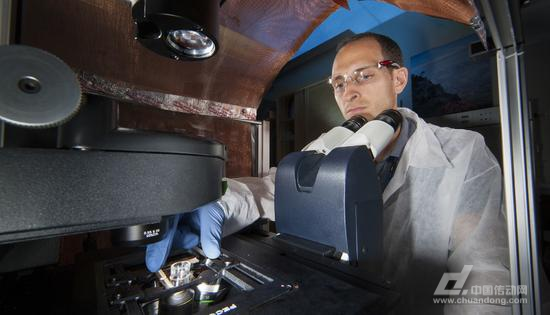Researchers are currently improving and improving "chip brain" technology. Scientists believe that with the maturity of this technology, it is no longer possible to conduct animal or even human clinical trials for many neurological diseases in the future.
January 16 news, according to Futurism website reports, the current researcher is improving and improving the "chip brain" technology. Scientists believe that with the maturity of this technology, it is no longer possible to conduct animal or even human clinical trials for many neurological diseases in the future.

Illustration: Dave Soscia, a researcher at Lawrence Livermore National Laboratory (LLNL), examines "chip brain" devices under a microscope
Chip Brain Technology BRAIN-ON-A-CHIP
It is reported that researchers at the Lawrence Livermore National Laboratory (LLNL) have developed new uses for "chip brain" technology: testing the effects of biological and chemical agents on the brain over time. His research was published in the PLoS One journal in November 2017. This research is an important work of a research institute dedicated to the development of "chip brain" technology. The researchers hope that through this study, the animal will not be subjected to related experiments of neurological diseases on a certain day.
The so-called "chip brain" technology is essentially a network of researchers who use semiconductor wires to create nanowires. When brain cells are introduced into the chip, they can use nanowires as scaffolds to construct functional neuronal circuits that simulate the interconnection of neurons in the brain. Once a simulated brain circuit is constructed, researchers can not only observe neural connectivity, but also study the impact of disease and trauma on it.
In January 2017, researchers at Harvard University's John A. Paulson School of Engineering and Applied Science (SEAS) pioneered the use of this “chip brain” device. The chip device enables researchers to identify differences in neurons based on the location of neurons in the brain and the connection between different neurons, and in particular, studies on schizophrenia and other diseases at the neurological level. analysis. Researchers at the Australian National University later improved the nanowire architecture and developed the first ever capable neuron circuit.
The latest applied research from Lawrence Livermore National Laboratory found that the technology can be used to study the long-term effects of biological and chemical agents on the brain. The current research team focuses on the chemical exposure that military personnel may experience. Due to the prevalence of post-traumatic stress disorder, military personnel have become the most interested patient population in neurological research.
Brain reaction to chemical agents
In their study, researchers focused on using their "chip brain" to study how brain cells are affected by a large number of chemicals and how these agents change the brain's research over time. It is hoped that through a deeper understanding of the existing mechanisms, corresponding antidotes can be developed to treat or prevent patients, and to protect military personnel and other groups in reality.
The "Chip Brain" device used by the Lawrence Livermore National Laboratory team has tailored specific inserts to allow them to model different areas of the brain and, if needed, to study the interconnectivity of the corresponding areas. This also allows researchers to place multiple different types of neuronal cells in areas that are much smaller than ever before, allowing easy transition from the "macro-to-micro world".
With this device, the research team is able to monitor the explosion of brain cells during communication (called the “action potential mode”) and let them know how this mutual relationship changes over time, especially when the brain is exposed. How will react in the case of chemical reagents, etc.
In an LLNL press release, iCHIP Principal Research Fellow Elizabeth Wheeler explained: “Obviously, at high doses, we know that exposure will be harmful, but what about those soldiers who are exposed to low levels of chemicals for a long time? It is unclear.In the future, with this equipment, we may be able to predict how the brain will be affected.If we understand its impact, then we can formulate a strategy to protect the soldiers."
No more experimental rats are needed?
Dave Soscia, an engineer and co-author of the paper at Lawrence Livermore National Laboratory, said: "Although we are still quite different from the complete re-understanding of the extracorporeal brain, related research is increasing the complexity of these devices. And we took an important step in the right direction. Our idea is to ultimately give people enough confidence in these devices so that the effects observed when chemicals or drugs enter the platform environment are similar to those we see in the human body. ."
The biologist Kris Kulp further explained: “You can simulate someone’s brief exposure to chemicals on the battlefield, and then observe within six months what kind of changes will occur in the corresponding neurons. Maybe they will start from He recovered from the exposure, but there are still some undesirable effects after six months from now. This is the only system that can perform such experiments on human cells.
The next step in the development plan is for the research team to work with computer scientists, statisticians, and others to help them analyze and simulate the experimental data provided by the device.
Stauff Clamp,Pipe Fitting,Parker Clamp
Standard Cable Ties Co., Ltd. , http://www.nscableties.com
没有评论:
发表评论